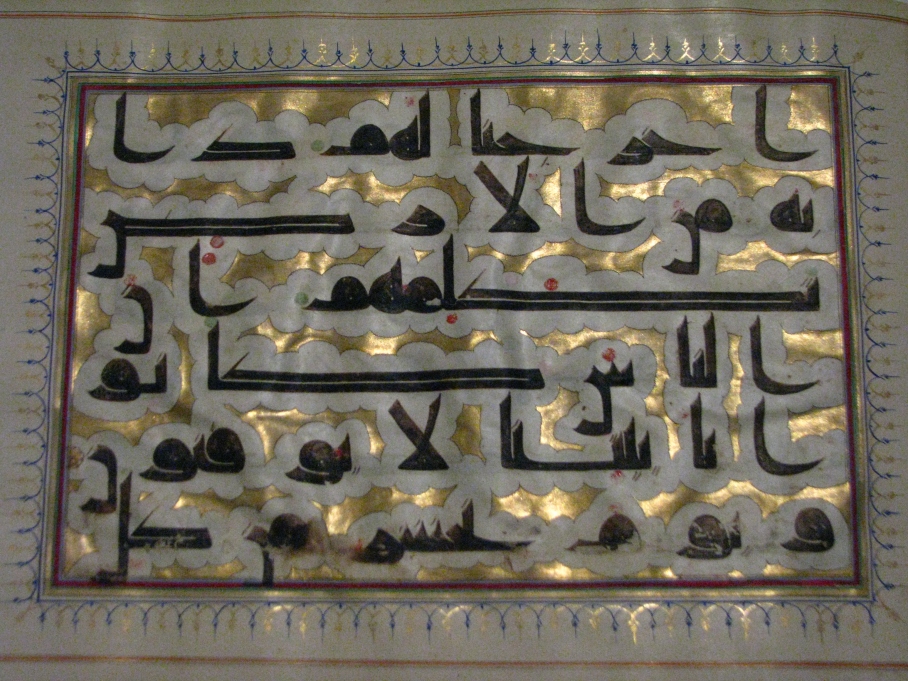Last weekend, I visited the Aga Khan Museum.

It is a new museum (it opened in 2014), and the first museum in North America dedicated to the arts of Muslim civilizations.
The museum has a large outdoor garden, grounds, and pools, which I did not get to fully appreciate on the cold winter day on which I visited.
I am sure that this area is absolutely gorgeous in the summertime.

As soon as you enter the museum, you see the atrium:

On the glass are mashrabiya patterns (an element of traditional Arabic architecture).

The museum has a permanent collection on the first floor featuring arts of several diverse Muslim civilizations, stretching from the Arab Near East to Iran and India, from the Atlantic to the Pacific.
Here is a brief description of Islam:

On to the artwork!
Here is an illustrated 11th century Qu’ran:

Here is another:

I am somewhat of a bibliophile, so I was very happy to see such beautifully illustrated books.
Below is a couple of pages from “The Book of the Images of Fixed Stars” by Umar al-Sufi. It was written in Iran in the mid 1600s.

Here is an absolutely stunning fountain made in Egypt in the 1500s.

Here is an astrolabe from 14th century Spain. It was used to “locat[e] and predict the positions of the Sun, Moon, planets, and stars, determining local time…in the Islamic world, it was also used to calculate the Qibla and to find the times for Salat, prayers.”

Here is a detail of of revetment tiles from 15th century Syria:


One entire side of the first floor is made of the mashrabiya pattern. The light coming through it changes the appearance of the wall throughout the day.

Below is a detail of a miniature painting from the “Book of Kings” (the Shahnameh).
“The Shahnameh is the world’s longest epic poetry written by a single poet. It tells mainly the mythical and to some extent the historical past of the Persian Empire from the creation of the world until the Islamic conquest of Persia in the 7th century.”
This painting is by Abd al-‘Aziz. Iran, 1522 to 1535.

“The work is of central importance in Persian culture, regarded as a literary masterpiece…”

The paintings are about 11 by 14, and contain so much detail that you can discover more by looking at them through a magnifying glass.
Pictured below is a “lavishly illustrated manuscript of the Khamsa or “five poems” of Nizami Ganjavi, a 12th-century Persian poet, which was created in the early 1590s.”

The manuscript has been described as “one of the finest examples of the Indo-Muslim arts of the book.”

Here is a rondache (shield) and helmet from Iran in the 19th century.

This was one of the most stunning works at the museum: a tapestry made of gold-plated and stainless steel pins on one side….

Millions of tiny pins…

…and velvet and silk on the other.

The work is called “Your Way Begins on the Other Side” and was created by Aisha Khalid in 2014.
As I walked through the museum, I felt a sense of serenity. The architecture of the place (as designed by Fumihiko Maki) invokes this feeling. Everything is streamlined and minimalistic. It is a nice compliment to the ornate and often elaborate artwork contained within the design.
Here is another shot of the beautiful atrium.

The museum also has a temporary collection on the second floor currently containing two exhibits. One was a series of photographs of Istanbul from the 1850s alongside a modern collection of distorted photographs of modern Istanbul by photographer Murat Germen.
The other was called “Doors Without Keys” by Abbas Kiarostami, a collection of large-scale photographs of locked doors from Iran, Italy, France, and Morocco. Both exhibits were absolutely outstanding, but unfortunately, no photography was permitted.
Temporary exhibits are included in the admission price. The museum also has an excellent restaurant called “Diwan” which is open at lunchtime.
A lot of the articles in the permanent exhibits change periodically to show more of them and also to protect them (as quite a few are made out of fragile materials such as paper).
The museum is also free on Wednesday nights from 4 to 8pm.
I am sure I will be visiting again in the springtime!
Stay tuned!
Sources:
Information about astrolabe: https://en.wikipedia.org/wiki/Astrolabe
Information about the Book of Kings: https://en.wikipedia.org/wiki/Shahnameh
Information about the Khamsa:
https://en.wikipedia.org/wiki/Khamsa_of_Nizami_(British_Library,_Or._12208)
Museum website: https://www.agakhanmuseum.org/